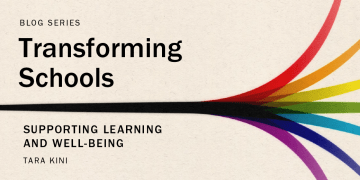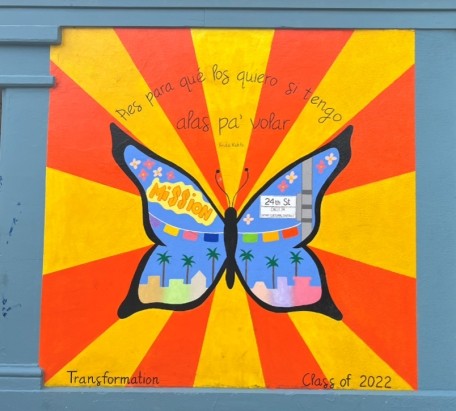Supporting Learning and Well-Being at San Francisco’s Buena Vista Horace Mann K–8 Community School

This blog is part of the Transforming Schools series, which shares effective practices and foundational research for educators, students, families, and policymakers who are reimagining schools as places where students are safe and can thrive academically, socially, and emotionally.

In the heart of San Francisco’s historically Latino Mission District stands Buena Vista Horace Mann K–8 Community School (BVHM). Murals dot the mustard-yellow façade of this Spanish dual immersion school, and one—a vibrant butterfly marked “Transformation Class of 2022”—is a fitting symbol for a school that is not only embracing change but leading it.
Among BVHM’s mostly Latino student population, approximately 60% are English learners, 75% are socioeconomically disadvantaged, 15% are students with disabilities, and 6% are experiencing homelessness. To effectively support these students, BVHM has adopted a community schools strategy—an approach that provides comprehensive support to students and families beyond traditional academic instruction.
What Does It Mean to Be a Community School?
Community schools organize in- and out-of-school resources and supports such as mental health services, meals, health care, tutoring, after-school programming, internships, and other learning and career opportunities that fit specific needs of their communities. Through this strategy, students, families, educators, and community partners come together to support student success. While the specific programs and services vary according to local context, key site-level practices include (1) expanded, enriched learning opportunities; (2) rigorous, community-connected classroom instruction; (3) a culture of belonging, safety, and care; (4) integrated systems of support; (5) powerful student and family engagement; and (6) collaborative leadership and shared power and voice.
Community schools are growing across the nation, and California has become a leader in implementation in recent years, supported by an unprecedented $4.1 billion investment through the California Community Schools Partnership Program. The program provides grants that enable school and district partnerships with community agencies and local government to support students’ academic, physical, and mental development.
A Strategy for Success: Braiding State and Local Funds
As a community school, BVHM “braids” state and local funding sources to support students and their families. From the state, the Expanded Learning Opportunities Program helps fund after-school and summer school enrichment programs, and grant funds from the Community Schools Partnership Program pay for the community schools coordinator and the on-site therapist. Further state funding comes from the state’s growing investment in the Local Control Funding Formula, which helps fund BVHM’s smaller class sizes that enable more personalized instruction.
Augmenting the state’s community schools strategy, San Francisco voters approved Proposition G in 2022, which created the city-funded Student Success Fund to address the urgent academic, social, and emotional needs sparked by the pandemic and support community school implementation in alignment with California’s Community Schools Framework.
With their students’ needs in mind, BVHM weaves these various state and local strands of funding together and incorporates community partners to help provide unique systems of support and nurture the whole child.
Building a Strong Foundation: Knowing Students Well to Support Them Well
BVHM creates a learning environment where each student can be well known, and thereby well supported. The school’s master schedule and investments in staffing support this goal.
Middle school students start their day with advisory, a safe space with 12 or fewer peers and an advisor. This class is held 4 days a week and provides both a dedicated time for students to create community and build social-emotional learning skills and the opportunity for teachers to quickly notice if there’s anything going on with a student that requires reaching out to their family. Advisors are the key link to families and to other adults in the school who ensure that students receive the supports they need when they need them.
To address academic needs as they arise, the school invests in two intervention teachers as well as “linked-day” staff. The latter are before- and after-school program staff who, in addition to working in the expanded learning program, come into classes during the school day to provide additional academic support, lead activities at recess, and build relationships with students who most need them.
BVHM’s schedule is structured to support collaboration among teachers and provide students with well-rounded, bilingual learning opportunities. Each grade-level team of three to four teachers has two 90-minute blocks of collaboration time weekly, allowing them to engage in shared lesson planning, review and align feedback on student work, and triage student wellness needs with their grade-level counselor. While teachers collaborate, elementary students enjoy a variety of “specials” classes, including technology, arts, music, dance, library, and PE.
Middle school students choose an elective seminar that caters to their interests while their teachers collaborate. The Mission District’s numerous cultural organizations are tapped to provide engaging and community-connected learning opportunities during these elective seminars. In addition to choices like art, weightlifting, and chess, there’s a capoeira class taught by a local studio; a local DJ leading a seminar called “Girls on the Mic”; a mariachi program; and a Tech Chicxs class designed to support girls’ interest in STEM and, according to teacher Laura Ramirez, develop “the tech leaders of the school.”
Nurturing the Whole Child: Addressing Physical and Emotional Well-Being
The community schools strategy understands that academic success is closely intertwined with students’ physical and emotional well-being. With one counselor for every two grades, as well as a family liaison, community school coordinator, and on-site therapist, BVHM provides students with comprehensive mental health support. This allows teachers to focus on academics while ensuring each child’s social and emotional needs are met. According to Principal Claudia Delarios Morán, “We’re a large school, but it comes down to how well each child is known. … The classroom teacher doesn’t have to be the case manager for the child and their family; they can focus on academics. That’s been a huge relief.”
BVHM provides intensive integrated supports to students and families, including through a food bank, eviction defense, and immigration assistance. The robust before-, after-, and summer school program, conducted in partnership with the Jamestown Community Center, provides academic support, enrichment activities, and opportunities for students to engage in athletics and the arts. Graduates of BVHM have come back to staff these programs while in high school and college—a testament to the strong relationships they have built with the school.
Caring for the Whole Family: Supporting Students and Families Experiencing Homelessness
One of BVHM's most remarkable initiatives is its “Stay Over Program” (SOP), an overnight shelter located in the school’s gymnasium and open to all San Fransisco United School District students and families experiencing homelessness. Born out of a recognition of San Francisco’s housing crisis, this partnership between the school, the district, and the city and county of San Francisco provides a safe haven for families in need.
The program is funded through San Francisco’s Department of Homelessness and Supportive Housing and operated by the nonprofit Dolores Street Community Services under a joint-use agreement with the school district, at a cost of $48 per bed. The school facility is used as a shelter for up to 60 people from 7:00 p.m. to 7:00 a.m. on school days and 24 hours on weekends and school breaks. It provides all-night staffing, food, and other supportive services. Families may stay as long as they need.
The SOP also connects families to city programs to help them secure more stable housing. Data from October 2023 indicate that since the program opened in 2019, 1,100 people have been served, and 223 families have found stable housing.
After 5 years of the SOP’s operation, Principal Delarios Morán reflects, “It’s like night and day for the students who have stayed there: All of a sudden, they don’t have to worry. They are in a place where they’ve already built relationships. It’s also had an effect on the larger community, because they know that if they ever got into trouble, they could stay here. It’s a safety net for everyone.”
Engaging and Empowering the Community: Everyone Gets Involved
The Stay Over Program is an example of BVHM’s collaborative approach to engaging students, families, and educators in decision-making and shared governance. What was initially a “divisive” conversation ultimately—through an extensive and transparent process of listening and responding to community input—resulted in wide support for the SOP. At a recent event, Community School Coordinator Nick Chandler described what has now become the school’s “natural operating method.” Chandler explained, “We looked at data, we engaged our organized bodies, we got feedback, we shared it, we looked at our options, and we made a decision that was equitable, student-centered, and there was consensus in the community.”
At BVHM, students, families, and educators inform major school decisions through various channels, including the English Learner Advisory Council, the PTA, a staff committee known as the Union Building Committee, and student government. Representatives from all groups serve on the School Site Council, which meets monthly to collaboratively determine the school’s budget. A recent budget decision, for example, addressed whether to invest in additional staffing for math or to make additional investments to support students with IEPs (the school decided on the latter, based on survey data and input from families).
As a dual immersion school serving a student population that is 90% Latino, accessibility and language diversity are prioritized; all meetings are held at convenient times for families and with interpretation provided, with meetings alternating between being held in English or Spanish. Parent Luz Rodríguez, president of the English Learner Advisory Council and former co-president of the PTA, explains, “Sometimes we have to be flexible and do [interpretation] in real time. But the important thing is: We don’t move forward in the meeting if there isn’t interpretation. This is how families have an opportunity to understand what is being discussed and know that their voice matters.” With a student government class and two students participating in the School Site Council, students are also actively involved in shaping school policies and decisions.
Transformation and Growth: A Strategy With Results
Research has shown that the community schools approach can lead to improvements in attendance, test scores, grades, grade promotion, and, ultimately, graduation rates, as well as students’ attitudes toward school and reduced racial and economic achievement gaps. At BVHM, early signs suggest the strategy is placing the school on a positive path forward.
The school reduced chronic absenteeism by 8 percentage points from 2021–22 to 2022–23, an even faster rate of improvement than the state and the city. Test scores have also increased, especially for students who were in the school in both years (a matched cohort that the school is able to track). The percentage of students in that matched cohort whose achievement levels met or exceeded the standard in 2022–23 increased by 5 percentage points in mathematics from the year before and by 8 percentage points in English language arts. These gains have been made even as the school has been serving an increasing number of newcomer students each year.
As parent Luz Rodríguez shared, “We know we have to work together to make a better education for our kids.” From the way the school is harnessing community resources and making families, students, and staff a key part school decision-making, it’s clear that this is happening at BVHM.
- Listen to BVHM staff, parents, and students describe their approach to shared decision-making in this California Partnership for the Future of Learning webinar: https://futureoflearningca.org/shared-leadership-power-for-school-transformation-part-ii/
- Listen to BVHM and Dolores Street Community Services staff describe the Stay Over Program for students and families experiencing homelessness in this SchoolHouse Connection webinar: https://www.youtube.com/watch?v=bV0EUmisIzk
